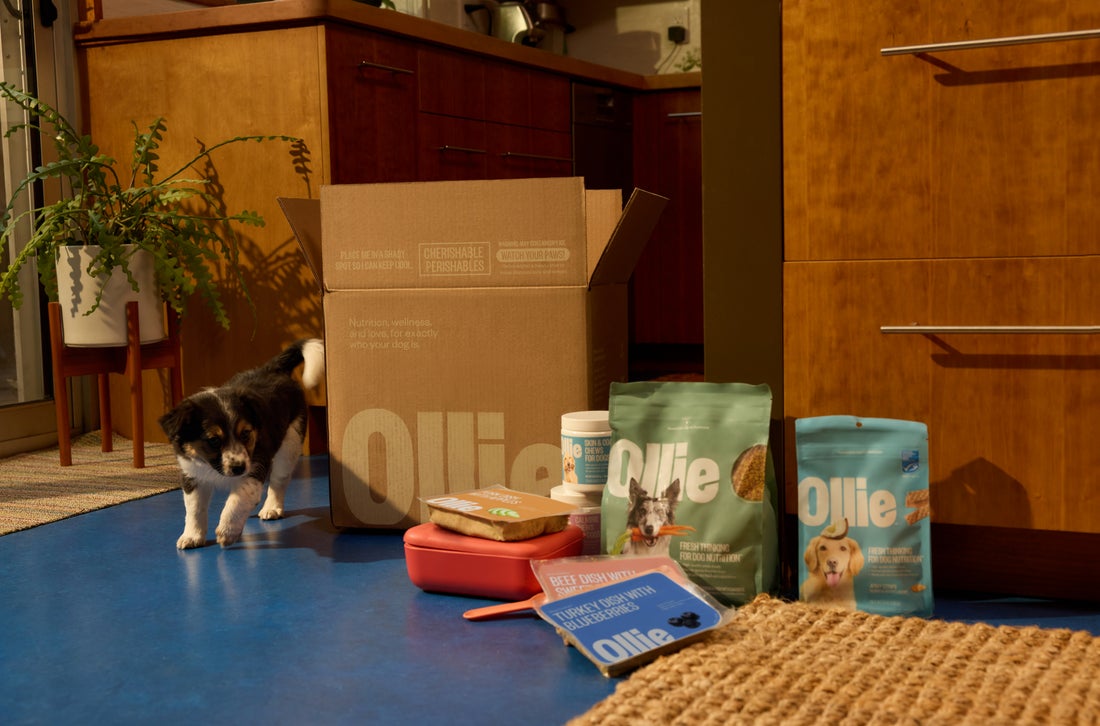Hey Ollie blog readers! We’re offering you an exclusive 60% OFF your starter box! Try now!
Chicken meal is a common ingredient in many dry and wet dog foods. Thanks to mainstream marketing, it’s also developed a reputation as an inferior protein substitute. So, is chicken meal as bad as everyone claims or victim to dog food industry hype? In this article, we’ll explore what chicken meal is, its nutrient profile, the role of protein in dog food, and some alternative fresh food protein options for pups.
What is Chicken Meal in Dog Food?
Chicken meal is a combination of chicken meat, skin, and bone, and is made by grinding, mixing, melting, and drying the ingredients at a high temperature. Chicken meal is considered to be high in protein and because it contains non-meat ingredients, it is generally more cost-effective than all-meat protein.
Nutritional Value of Chicken Meal
In its uncooked state, chicken meal is an excellent protein source for dogs, fueling muscle and cartilage development and maintenance, and supporting nearly every process in the body. Chicken bones and cartilage are also rich in glucosamine, which can help support your dog’s joint health. However, because chicken meal undergoes extensive processing and high-temperature cooking, some of the initial nutrient content is destroyed. Additionally, this lengthy processing can make it difficult for many dogs to digest, further compromising any nutritional benefit and potentially causing discomfort.
Why is Chicken Meal Used in Dog Food?
Despite these significant deficiencies, why is chicken meal such a popular ingredient in many dry and wet dog foods?
Cost Effectiveness
Chicken meal is more cost-effective than muscle meat, as it also contains bone and skin. And because it contains less water than chicken meat, it’s also easier to render, process, and measure for wet and dry food formulas.
Shelf Life
As a ground and dried ingredient, chicken meal has a long shelf life and does not require refrigeration. When securely packaged, chicken meal can remain fresh for months, enabling dog food manufacturers to transport the finished product across great distances to stores and other distributors.
Is Chicken Meal Different From Chicken By-Product?
Chicken meal and chicken by-product are often confused, but feature different components and have different nutrient profiles. Chicken by-product contains the ingredients left over after the meat, skin, and bone are used to create chicken meal. This includes organ meat such as the liver, spleen, and intestines, as well as the neck, feet, and carcass. While this may sound disturbing, these components do contain various minerals, vitamins, and other beneficial compounds such as glucosamine—unfortunately, these are often degraded by processing. Finally, because it lacks muscle meat, chicken by-product is an inferior protein source when compared to chicken meal and chicken muscle meat.
Fresh Food: An Alternative to Chicken Meal
If you’re wondering why chicken meal doesn’t appear on any products in your pantry or refrigerator, it’s because the ingredient is not human grade. Fortunately, fresh dog food such as Ollie’s chicken recipe makes it easy to ensure you’re filling your pup’s bowl with the same quality ingredients that fill your dinner plate. In addition to building every recipe with fresh healthy foods, each ingredient’s natural nutrients are preserved through gentle cooking—ensuring every bite is packed with balanced protein, carbohydrates, fiber, vitamins, minerals, and of course, flavor.
Benefits of Protein in a Dog’s Diet
Protein is an essential component of canine nutrition, supplying key components for nearly every physiologic process from nose to tail. Major health benefits of dietary protein include:
Supporting Muscle Development
From your puppy’s early growth and development, to maintaining physical fitness and agility in adulthood, to preventing muscle atrophy (i.e., loss) during your dog’s senior years, protein—especially high-quality animal protein—supports muscle growth, repair, and breakdown.
Supporting Healthy Skin and Coat
Your dog’s skin and hair contain protein, meaning that this ingredient builds and supports your pup’s first line of defense against the outside world. Appropriate levels of dietary protein ensure a healthy skin barrier and a lustrous full coat.
Supporting Healthy Digestion
High-quality dietary protein aids in digestion by creating a sense of satiety (i.e., fullness), which can reduce overeating and scavenging. Additionally, consumed protein helps create and activate digestive enzymes which break down foods to increase nutrient absorption through the intestine and into the bloodstream. Finally, protein supports healthy digestion by repairing and restoring the intestinal lining.
In summary, chicken meal is a highly processed dog food ingredient that offers dog food manufacturers a cost-effective and convenient protein source. While this ingredient isn’t harmful to dogs, we at Ollie believe there are better ways to nourish our four-legged friends—starting by feeding them like real family members, with fresh human-grade ingredients that are gently cooked, strategically portioned, and packed with healthy nutrition.
The Ollie blog is devoted to helping pet parents lead healthier lives with their pups. If you want to learn more about our fresh, human-grade food, check out MyOllie.com.
Tagged As:

The nutrition your dog needs,
the food they want.

Enjoying our articles? Subscribe our Newsletters and get new articles directly to your inbox
You might also like
30 July 2025
3 MINS READ
The Poop Scoop: Your Dog Digestion Questions Answered
As pup parents, we spend a lot of time handling dog poop, and as a key indicator of a dog’s health, it’s only fitting that we think and talk about it just as much. Unfortunately, what happens …
23 June 2025
7 MINS READ
Can All Dog Breeds Eat Fresh Dog Food?
Every dog is different, but here’s the good news: with the right approach, fresh food can work for every breed. Whether you’ve got a couch-loving French Bulldog or a high-energy Border Coll…
by Ollie Pets
23 June 2025
7 MINS READ
How Do I Transition My Dog To Fresh Food?
Making the switch to fresh food is one of the best things you can do for your dog’s health, but it’s not something you want to rush. Even if your pup is excited about their new meals, their di…
by Ollie Pets







